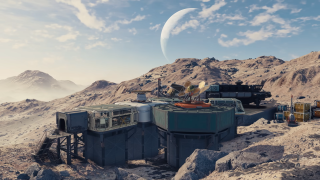Congratulations, Starfield explorer. You have traveled to the far reaches of space, where Preston Garvey can never bug you about a settlement that needs help ever again. But now we have a different settlement problem to deal with.
That is, we need some kind of settlement to live in since there might be radiation or giant bugs or the bad air that makes your lungs hurt outside. That's where Starfield's outposts come in. Your home away from home.
We don't know everything about how Starfield's outposts will work just yet, but there is a lot of information out there from the gameplay videos Bethesda has released over the past few years. Here's what we know so far about Starfield outposts, modules, and attributes.
Building Outposts in Starfield

To build an outpost in Starfield, you're going to need skills and materials. The main skill that's involved in the actual construction is called Outpost Engineering, which is part of the Science group.
Materials like iron and aluminum, initially, will have to be purchased or gathered on foot, then loaded up into your ship for transport to the outpost site. Once you have one or more outposts chugging along, though, you'll be able to have them gather resources passively. Just be aware that not all resources needed for outpost construction are available on every planet. So when picking a main base, you probably want somewhere that has a lot of the most needed resources available locally.
Outpost building in Starfield is fully modular and allows you to snap various pieces together in any configuration you want, assuming the terrain allows it. Some modules even have multiple variants to choose from that serve the same function, allowing you more control over the visual aesthetic of your outpost.

Starfield Outpost Modules
Outpost Airlock: Required to enter/exit the pressurized, habitable environment of your outpost.
Four-wall Hab: A flexible living chamber with a square shape.
Hydroponic Hab: Used for growing various plants, available in a square or round configuration.
Small Science Hab: A module for doing Science, such as using the Chemistry skill to make chems.
Small Hex Hab: A flexible living chamber with a hexagonal shape.
Hallway - Industrial: A corridor that connects two habs together. This one has a very functional, no frills look to it.
Outpost Beacon: We're not sure what this does yet, but it may be a way to add a nav point to your outpost so you can get back to it quickly from a far-away location on the same planet, or find it easier when landing from space.
Military Hab: It looks like a bunker. It may simply be a place to store and craft weapons, or it may also be able to serve as a defensive position when defending the outpost from attack.
Watchtower: A place to get a commanding view of your surroundings, as well as a great launching point for some sick jump pack moves.
Starfield Outpost Attributes

Power: How much power the outpost is producing and consuming. Every module has an operating cost in Power. Smaller outposts might be able to run on just wind turbines, but the bigger you build, the more you're going to need.
Build Limit: Outposts do seem to have a maximum number of modules that can be placed, though from what we've seen so far, it's rather high. Probably enough to make a smallish city.
Cargo: The amount of stuff currently stored at the outpost, which may be transferred from your ship or collected automatically from the planet.
Crew: How many of your NPC buddies you have stationed at the outpost. It's possible to have outposts that are completely self-sufficient while you're gone if you hire the right crew.
Production: How many raw resources the outpost is producing.
Starfield Outpost Management

There is a separate skill in Starfield for Outpost Management, which we haven't seen much info on yet, but is likely related to how efficiently you can keep an outpost running. Outpost Engineering lets you build outposts better, and Outpost Management lets you get the most out of them.

